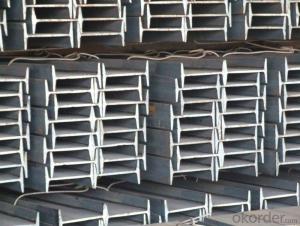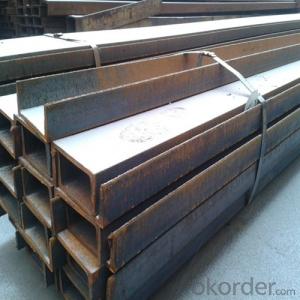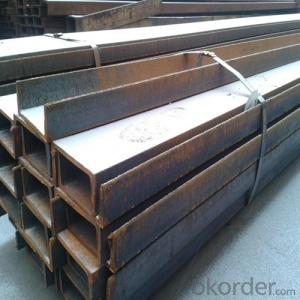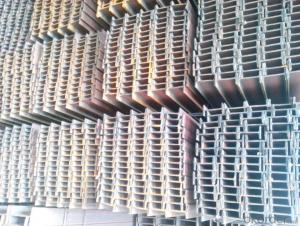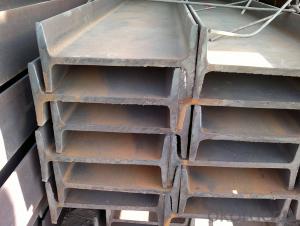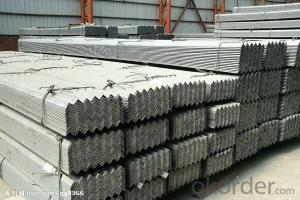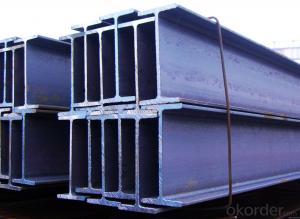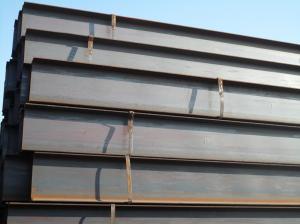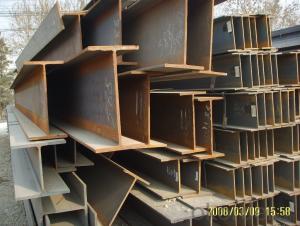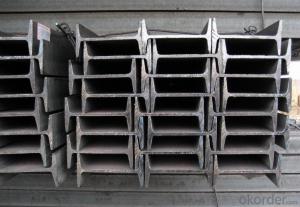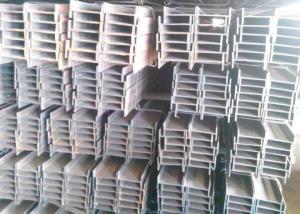Standard Hot Rolled Steel I-Beam
- Loading Port:
- Qingdao
- Payment Terms:
- TT or LC
- Min Order Qty:
- 300 PCS
- Supply Capability:
- 40000 PCS/month
OKorder Service Pledge
OKorder Financial Service
You Might Also Like
Standard Hot Rolled Steel I-Beam
OKorder is offering high quality Standard Hot Rolled Steel I-Beams at great prices with worldwide shipping. Our supplier is a world-class manufacturer of steel, with our products utilized the world over. OKorder annually supplies products to European, North American and Asian markets. We provide quotations within 24 hours of receiving an inquiry and guarantee competitive prices.
Product Applications:
Standard Hot Rolled Steel I-Beams are ideal for structural applications and are widely used in the construction of buildings and bridges, and the manufacturing, petrochemical, and transportation industries.
Product Advantages:
OKorder's Steel I-Beams are durable, strong, and resist corrosion.
Main Product Features:
· Premium quality
· Prompt delivery & seaworthy packing (7-10 days after receiving deposit)
· Corrosion resistance
· Can be recycled and reused
· Mill test certification
· Professional Service
· Competitive pricing
Product Specifications:
Brand: Baoming
Grade: SS400 – SS490, Q195, Q215, Q235
Model Number: 10# – 63#
Dimensions:
Leg Height: 100 – 630mm
FAQ:
1: Why buy Materials & Equipment from OKorder.com?
A1: All products offered byOKorder.com are carefully selected from China's most reliable manufacturing enterprises. Through its ISO certifications, OKorder.com adheres to the highest standards and a commitment to supply chain safety and customer satisfaction.
Q2: How do we guarantee the quality of our products?
A2: We have established an advanced quality management system which conducts strict quality tests at every step, from raw materials to the final product. At the same time, we provide extensive follow-up service assurances as required.
Q3: How soon can we receive the product after purchase?
A3: Within three days of placing an order, we will begin production. The specific shipping date is dependent upon international and government factors, but is typically 7 to 10 workdays.
Q4: What makes stainless steel stainless?
A4: Stainless steel must contain at least 10.5 % chromium. It is this element that reacts with the oxygen in the air to form a complex chrome-oxide surface layer that is invisible but strong enough to prevent further oxygen from "staining" (rusting) the surface. Higher levels of chromium and the addition of other alloying elements such as nickel and molybdenum enhance this surface layer and improve the corrosion resistance of the stainless material.
Q5: Can stainless steel rust?
A5: Stainless does not "rust" as you think of regular steel rusting with a red oxide on the surface that flakes off. If you see red rust it is probably due to some iron particles that have contaminated the surface of the stainless steel and it is these iron particles that are rusting. Look at the source of the rusting and see if you can remove it from the surface.
Images:
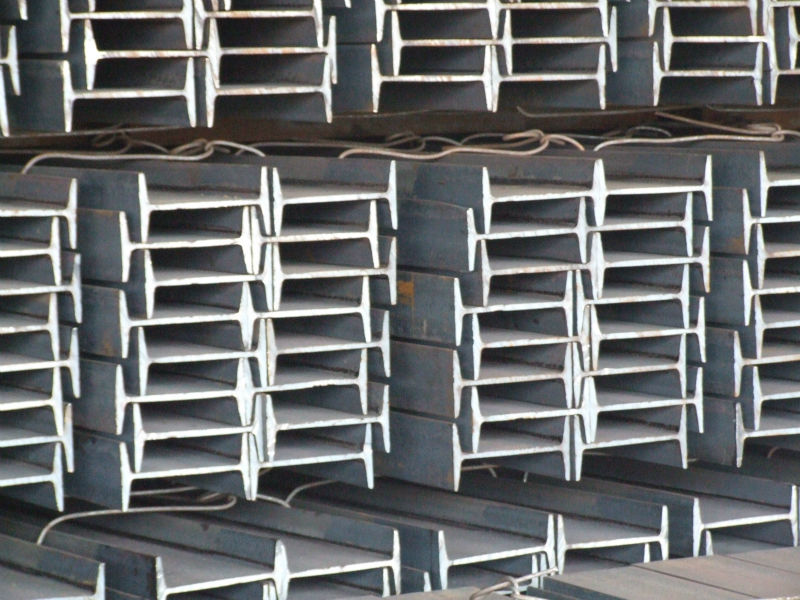
- Q: Can steel I-beams be used in off-grid or remote construction projects?
- Yes, steel I-beams can definitely be used in off-grid or remote construction projects. Steel I-beams are a popular choice in construction due to their strength, durability, and versatility. They are commonly used in building structures, bridges, and other heavy-duty applications. In off-grid or remote construction projects, steel I-beams can provide several advantages. Firstly, their strength allows for the construction of sturdy and long-lasting buildings that can withstand harsh weather conditions and natural disasters. This is particularly important in remote areas where resources for repairs and maintenance may be limited. Additionally, steel I-beams are relatively lightweight compared to other construction materials such as concrete or wood, making them easier to transport to remote locations. Their modular nature also allows for efficient assembly and disassembly, making them suitable for temporary structures or projects where mobility is required. Furthermore, steel I-beams can be pre-fabricated off-site and transported to the remote location, reducing the need for extensive on-site construction and minimizing the environmental impact. This is especially beneficial in off-grid projects where access to equipment and construction materials may be limited. Overall, steel I-beams are a practical and reliable choice for off-grid or remote construction projects. Their strength, durability, and ease of transportation make them ideal for constructing robust structures in challenging environments.
- Q: What are the different types of steel I-beam profiles?
- There are several different types of steel I-beam profiles commonly used in construction and engineering projects. Some of the most common types include: 1. W shape: This is the most commonly used I-beam profile and is characterized by its wide flanges and straight web. It provides excellent strength and stability, making it suitable for a wide range of applications. 2. S shape: The S shape I-beam has tapered flanges and a thinner web compared to the W shape. It is often used in situations where lighter weight and flexibility are required, such as in architectural and aesthetic applications. 3. HP shape: The HP shape I-beam stands for "H-pile" and is used primarily in deep foundation applications. It is characterized by its wide flanges and thick web, providing excellent load-bearing capacity in situations where high strength and stability are crucial. 4. M shape: The M shape I-beam, also known as a "miscellaneous" shape, is less common and typically used in specialized applications. It has unequal flanges and a thinner web, making it suitable for unique structural requirements. 5. L shape: The L shape I-beam, also known as an angle iron, is characterized by its 90-degree angle and is commonly used for smaller-scale structural applications, such as framing and support brackets. These are just a few examples of the different types of steel I-beam profiles available. The choice of profile depends on the specific requirements of the project, including load-bearing capacity, size limitations, and aesthetic considerations.
- Q: What are the considerations for steel I-beam design in extreme temperatures?
- When designing steel I-beams for extreme temperatures, there are several crucial factors that need to be taken into consideration. To begin with, it is of utmost importance to comprehend the impact of temperature on the mechanical properties of the steel. As the temperature increases, the strength and stiffness of the steel decrease, and this reduction can be quite significant under extremely high or low temperatures. Consequently, the design must account for these variations in material behavior to ensure the structural integrity and safety of the I-beam. Another factor to consider is thermal expansion and contraction. When heated, steel expands, and when cooled, it contracts. This thermal movement can introduce stresses and potential deformations in the I-beam. To address these effects, appropriate expansion joints or allowances should be integrated into the design, allowing for thermal movement without compromising the overall stability of the structure. In extremely cold temperatures, steel becomes more brittle, thereby increasing the risk of fracture. Therefore, the design should incorporate measures to prevent brittle fracture. This can be achieved by utilizing steel grades with good low-temperature toughness or by including additional reinforcement to enhance the beam's resistance to cracking. Furthermore, extreme temperatures can also impact the corrosion resistance of steel. In high-temperature environments, steel may be exposed to aggressive chemical reactions that expedite corrosion. Therefore, it is crucial to apply suitable protective coatings or materials to prevent corrosion and prolong the service life of the I-beam. Moreover, it is vital to consider the effects of temperature on the surrounding environment. For instance, if the steel I-beam is exposed to extreme heat, such as during a fire, it may require a design that can withstand elevated temperatures for a specific duration to ensure structural stability and prevent collapse. All in all, the design of steel I-beams for extreme temperatures necessitates a comprehensive understanding of material properties, thermal expansion, the potential for brittle fracture, corrosion resistance, and the surrounding environment. By carefully considering these factors, engineers can develop robust and safe designs capable of withstanding extreme temperature conditions.
- Q: What is the maximum span for steel I-beams?
- The maximum span achievable for steel I-beams is contingent upon various factors, encompassing the I-beam's type and size, the load it necessitates supporting, and the permissible deflection or sag. Generally, larger and more robust I-beams have the capacity to span greater distances. In the realm of customary residential or commercial construction, the maximum span for steel I-beams may fluctuate anywhere between 20 and over 100 feet. Nevertheless, it is of utmost importance to seek the counsel of a structural engineer or architect to ascertain the suitable size and span for a particular application. Additional considerations, such as adherence to building code requirements, the nature of the load (such as dead load, live load, wind load, etc.), and the desired level of deflection control, also play a role in determining the maximum span. Ensuring that the chosen steel I-beam can securely support the intended load without excessive deflection or structural failure is of paramount importance. Thus, it is highly recommended to consult a professional who can meticulously analyze the specific project requirements and offer appropriate guidance regarding the maximum span achievable for steel I-beams in a given scenario.
- Q: I want to use a lever beam point, two meters away from the middle of the fulcrum, to lift two tons half the weight of I-beam with much?
- Generally, stainless steel needs the worst stress, slightly better carbon steel, and low-alloy steel is the best. But in low alloy steels, the steels with higher strength tend to have lower toughness and worse toughness. They require severe deflection and overall instability, but will reduce the load-carrying capacity of the steel, increase the size and waste the material.Generally on the market, the common Q235-B, Q345, more. The parameter you are giving is incomplete. I wonder if you could estimate the coefficient of the lifting dynamic load If the dynamic coefficient of the 1.65 of the general equipment lug is concerned, the overall instability will be a destructive factor. You're more reliable than 20A or 20b i-beam. I think it would be safer to smash 250B I-beam if I often throw it crosswise. But the weight of 2 and a half tons is very low. Not very tall. The steel structures I make often hoist more than 60 tons.
- Q: What type of I-beam should be used for span 8m? Beam load is mainly 10cm thick concrete floor
- The span 8m should be made of 20# I-beam @1000, and the ends should be solid. The main load is 10cm thick concrete floor.
- Q: Are there any health or safety concerns associated with steel I-beams?
- Yes, there are potential health and safety concerns associated with steel I-beams. These concerns primarily revolve around the handling and installation process. Steel I-beams are heavy and require proper lifting equipment and techniques to prevent accidents and injuries. Additionally, workers need to be cautious of sharp edges and corners that can cause cuts and bruises. It is crucial to follow safety protocols and wear personal protective equipment to mitigate these risks.
- Q: How are steel I-beams installed in construction projects?
- Steel I-beams are commonly used in construction projects due to their strength and stability. The installation process of steel I-beams involves several steps. Firstly, the structural engineer determines the appropriate size and length of the I-beam required for the specific project. The I-beams are then ordered from a manufacturer based on these specifications. Once the I-beams are delivered to the construction site, a crane is typically used to lift and position them into place. A crew of skilled workers, including ironworkers, riggers, and crane operators, work together to carefully maneuver the I-beam into position. In many cases, the I-beams are bolted or welded to the supporting columns or foundation. This ensures a secure and stable connection. The use of high-strength bolts or welding techniques depends on the specific design and requirements of the project. Before the final installation, the I-beams are aligned and leveled to ensure they are in the correct position. This is crucial for the overall structural integrity of the building. During the installation process, safety measures are of utmost importance. Workers wear protective gear and follow strict safety protocols to prevent accidents and injuries. In summary, steel I-beams are installed in construction projects through a combination of careful planning, skilled labor, and the use of cranes. The beams are typically bolted or welded to the supporting structure to ensure a strong and stable connection. Safety measures are always prioritized to ensure a successful and secure installation process.
- Q: Can steel I-beams be used for exhibition halls?
- Yes, steel I-beams can be used for exhibition halls. Steel I-beams are commonly used in the construction industry for their strength, durability, and load-bearing capabilities. Exhibition halls often require large open spaces with minimal obstructions, and steel I-beams provide the necessary structural support to achieve this. They can span long distances and support heavy loads, which is crucial for exhibition halls that often have large displays, equipment, and crowds of people. Additionally, steel I-beams can be designed and fabricated to meet specific architectural and aesthetic requirements, allowing for flexibility in the overall design of the exhibition hall.
- Q: What are the different surface treatments available for steel I-beams?
- Some common surface treatments available for steel I-beams include hot-dip galvanizing, painting, powder coating, and epoxy coatings. Each treatment provides different benefits such as corrosion resistance, improved aesthetics, and increased durability. The choice of surface treatment depends on the specific requirements of the application and the environment in which the I-beams will be used.
Send your message to us
Standard Hot Rolled Steel I-Beam
- Loading Port:
- Qingdao
- Payment Terms:
- TT or LC
- Min Order Qty:
- 300 PCS
- Supply Capability:
- 40000 PCS/month
OKorder Service Pledge
OKorder Financial Service
Similar products
Hot products
Hot Searches
Related keywords
